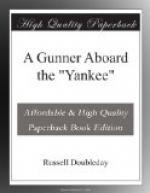We one and all wished we owned yachts and could invite some of the other officers—“Cutlets” in particular.
Blockading duty is monotonous work, though the strain on the lookouts is intense. During the day, a bright lookout must be kept for the lightest tinge of smoke on the horizon, and at night for the faintest glimmer of light, or a deeper shadow on the rim of the ocean that would betray a ship.
It was Tuesday night, and time hung heavy on our hands. Eight bells had not sounded, and, though hammocks had been given out, neither watch could turn in. It was with particular glee, therefore, that we welcomed the news that “Steve” had composed an up-to-date verse to his “Tommy Atkins” song. After some persuasion—for he is a modest chap—he consented to sing it for us.
“The first two verses
of this song were writ
Before we sailed
away for Cuba’s Isle;
And since that time the Spaniards
we have fit,
And chased their
gunboats many a weary mile.
We’ve heard the bullets
whistling overhead.
We’ve heard
the shells fly by and called it sport,
And
down at Cienfuegos
We
proved ourselves courageous
By tackling both
a gunboat and a fort.
Chorus.
“Now we’d
like to run a ferry,
All
along the Jersey shore;
Fighting Spaniards,
it is very
Nice,
but we don’t want—no more.
We would give
our bottom dollar,
And
of that you need not fear,
Just to hear the
masthead holler
Brooklyn
navy yard is here.”
“That’s very good, ‘Steve,’” said Greene, “but I can’t quite agree to that line: ’Fighting Spaniards it is very nice, but we don’t want—no more.’ I’d like to have a few more raps at ’em.”
“You are such a bloodthirsty chap,” said Flagg, “you slam the charges into your old Number Seven as if you would like to wipe out the whole enemy with one fell swoop.”
“Well,” replied Greene, thoughtfully, “a man does get awfully excited when the guns begin to bark.”
And every one of us knew exactly how he felt.
We maintained a close vigil until the sixteenth of June—two days later—then sailed for Santiago. Shortly after entering port we were informed that the Spanish gunboat with which we had been engaged off Cienfuegos had sunk, sent to the bottom by our fire; a bit of news highly appreciated.
Our stay in Santiago was short, the “Yankee” leaving for Guantanamo the next day at eleven o’clock. On reaching the latter port we found evidences of a considerable change in the condition of affairs. On our former visit, as the reader will remember, we had engaged in an interesting argument with a gunboat, a blockhouse, and a fort, driving the boat back into the harbor and silencing the fort. The good work done that day had borne fruit.
On entering the bay we found several of our vessels quietly riding at anchor—the “Oregon,” “Marblehead,” “Dolphin” (of railway-train fame), the ambulance ship “Solace,” the “Panther,” “Suwanee,” and three or four colliers and despatch boats.




